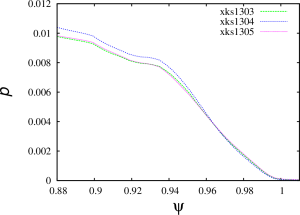XGC0 analysis for the KSTAR discharge 7328
The KSTAR equilibrium with an intentionally relaxed pedestal which is below the PB stability boundary (case# s13-t00-06) is studied using the XGC0 code. There XGC0 simulations are performed to investigate the pedestal dynamics for different plasma collisionalities. The first case (xks1303) uses the density and temperature that are used to generate this equilibrium. The pedestal density is set to and the electron and ion temperatures are set to 500 eV. The pedestal temperature in two other XGC0 cases is varied slightly above the experimental error bars. The temperatures in the second case (xks1304) are set to 800 eV and temperatures in the third case (xks1305) are set to 300 eV. The density in these two cases are changes to keep the total plasma
pressure unchanged. The
density is set to in the case xks1304 and to
in the case xks1305. The plasma collisionality for the case xks1304 is 4.38 times smaller than the plasma collisionality in the case xks1303 and the plasma collisionality in the case xks1305 is 4.63 times larger than the plasma collisionality in the case xks1303. The plasma collisionalities for the cases xks1305 and xks1304 differ by a factor of 20. Comparing the XGC0 results for the normalized plasma pressure that are given below, one can notice that the pedestal width is reducing for the low conditionality case.
Also, the pedestal height continue to grow at larger pace for the low collisionality case. This comparison can give a range of expected pedestal widths for the initial temperatures varied within experimental error bars.
There are significant differences in the bootstrap current predictions:
The bootstrap currents differ by a factor of 2.5 for these three cases that are still within the experimental error bars.
All XGC0 profiles are smoothed to remove the MC noise. Please note that the profiles continue to evolve and XGC0 simulations for these cases will be continued until quasi-steady states are obtained.



Leave a Reply